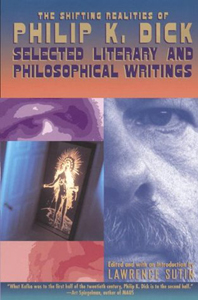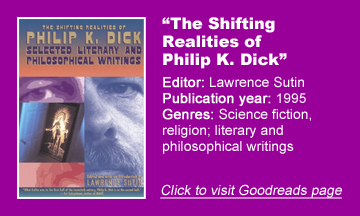Lawrence Sutin follows up his excellent biography of Philip K. Dick, 1989’s “Divine Invasions,” with a peek at his research materials as he curates “The Shifting Realities of Philip K. Dick: Selected Literary and Philosophical Writings” (1995).
This collection of Dick’s essays, speeches, journaling and other odds and ends is tantalizing for burgeoning PKD addicts and also a good one-stop shop for those who want a basic grounding in the author’s ideas and life outlook.
Leaves us wanting more
The unavoidable downside to this collection’s tantalizing nature is that it leaves us wanting more; we’re reminded that Dick died at 53, leaving projects unfinished. “Shifting Realities” includes the two chapters he wrote for a sequel to “The Man in the High Castle,” which would’ve been his first narrative sequel (the “VALIS” novels are labeled as a series, but they are connected thematically more so than narratively).
After learning from “MITHC” that there are multiple dimensions, the Nazis begin to search for a portal. It’s not all for naught, as Season 4 of TV’s “Man in the High Castle” has embraced and expanded upon Dick’s idea.
We also get Dick’s proposal for a “Mission: Impossible” episode, featuring a hilarious amount of twists and turns that was apparently too much even for that series.
The rarely discussed normal side of the author is revealed by the basic fact that he watched “M:I,” rather than spending all his hours writing, sleeping and seeing to whatever family unit was in the process of crumbling.
Dick never wrote an autobiography, so Sutin’s inclusions of the author’s short bios – for the purposes of blurbs in his books – are important to include here, but honestly they are a little thin. The biggest value of “Shifting Realities” comes in the book’s back half: speeches, essays and selected “Exegesis” entries.
Entering the ‘Exegesis’
This is where Dick interprets his 2-3-74 experience. These writings give us the foundation of his “VALIS” quadrilogy; while those books are fiction, they are based on PKD’s view of the spiritual cosmos. Sutin front-loads the best writings, so it gets redundant as you go further along; “Shifting Realities” might be best served as something you dip into now and then, rather than reading it straight through.
PKD approaches reality’s structure from a variety of angles but comes back to the same basic points. One metaphor that clicked with me is his comparison with a ham sandwich.
One slice of bread is God/VALIS, the ham is “the artifact,” and the other slice of bread is humanity. The artifact is the projected reality (what we see around us, particularly characterized by evil institutions), and it prevents God and humanity from connecting.
If a human could link up with God/VALIS, he or she would see the true reality; Dick believed he got a glimpse of this true reality in 1974. On a related note, God – who can operate outside of linear time — is constantly adjusting the true reality as he works toward improving it.
(Here, Dick inadvertently but perfectly describes how the timelines and realities of the “Terminator” saga – which began after his death but is influenced by Dick’s work more than is recognized – can all exist even if they contradict each other.)
I completely believe that Dick believed in this VALIS structure, and I’m tempted to believe it myself, since he cites so many religious writings (mostly from the Bible, but not exclusively) that play cogently and literally (rather than metaphorically) when placed against Dick’s theory. (For example, the seemingly contradictory notion that God is everywhere and yet we are separated from God.)
To be fair, Dick does not cite writings that contradict his viewpoint, and I haven’t done any research to find out if there are such writings, but I would guess there are in massive texts such as the Bible.
Again, the disappointment of Dick dying amid his explorations hits me when reading these essays. He focuses almost entirely on his own experiences and interprets them through the lens of classic religious writings.
Ongoing quest for answers
Perhaps the next step in his journey would’ve been to see if other people had experiences that fit the VALIS mold – either specific people’s experiences or common phenomena. For instance, I think PKD could’ve worked déjà vu, the Mandela Effect and bizarre but common human behaviors into his concept of an always-adjusting true reality.
PKD shows sympathy for Joe Schmo in his writings – as he does in his novels – but he doesn’t dig into evil actors within the artifact world (what we see as reality). It seems he believes the Ferris Fremonts (Richard Nixons) of our world are humans just like you and me, but PKD doesn’t dig into what drives those people.
They are wired to desire power and to lack compassion, but how and why are they that way? And why are some good people drawn to the power of bad people? This is another downside of Dick – an empathetic and moral (if flawed) man — primarily drawing from his own experience in these writings.
As PKD fans and as humans seeking the answers about our origin, we were robbed of additional years of Dick’s explorations when he died. Who knows; he might have later abandoned his VALIS structure. But he was onto something, and at least the foundation of his theory is clearly outlined in “The Shifting Realities of Philip K. Dick.”
From a biographical standpoint, these writings also support what Sutin portrays in “Divine Invasions”: that Dick’s ideas were wild and passionate, but his thought processes were entirely coherent and his research was impeccable.



